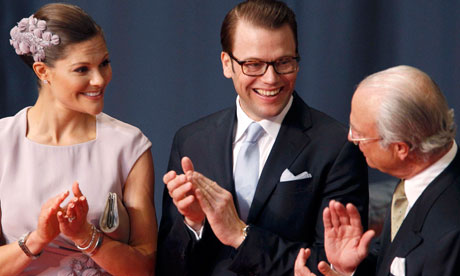 |
| Princess Victoria, her fiancé Daniel Westling and King Carl XVI Gustaf applaud during a reception at Stockholm City Hall 19th June. Photograph: Bob Strong/Reuters |
The following comes mainly from an article I read in the Swedish daily Svenska Dagbladet on 18th June (the day before the wedding).
The controversy arose when Victoria decided that her father the king should walk her up the aisle and give her away. The way the article framed the debate was instructive. Opponents of the giving away (brudöverlämning) call it hollywoodsk – imported from Hollywood movies. Svenska Dagbladet reported an opinion poll that showed 70% in favour of the brudöverlämning – or more accurately, in favour of Victoria being allowed to have her wish.
The question in the poll was : “Crown Princess Victoria wishes to be led to the altar by her father the king, and handed over to Daniel Westling. The officiant at the wedding, archbishop Anders Wejryd, has instead advised the bridal pair to follow the Swedish tradition where the woman and man walk to the altar together. Do you think that Victoria and Daniel should follow their own wish with the giving away, or do you think that they should follow the Swedish tradition and walk to the altar together?”
The response was 70% to 23% for Victoria and Daniel following their own wish, with women in favour even more strongly than men. Social democrat voters favoured it more than left party voters (former communist).
Annika Borg, a doctor of theology and a priest, kicked the debate off in a newspaper article in April. She is quoted as saying : “Naturally people answer yes when you frame the question in this way. No-one is going to think that people should not follow their own desires. That people must be able to do as they like is the highest good in our culture. But with symbols, the question is not so simple. … There is no reason to introduce a tradition of the father giving the bride away. The fact that you may think this fits in better with your personal plans is immaterial. Perhaps an individual sets no store by tradition, yet for all that, symbols are more important than any individual’s right to choose.”
I like what this Annika Borg says here. It's spot on. Until last week I didn't know about this Swedish tradition. But now that I do know, I’m proud to be associated with a country that has it, and I’m disturbed that it’s under threat.
She says that she has on occasion been faced with couples who want the father to give the bride away - and up to now she has always succeeded in persuading them otherwise. But it’s going to be a whole lot harder if Victoria and Daniel get their way. “We’ll find it hard to argue the point. It sets the standard for the Swedish church’s right to determine its own services.”
Archbishop Anders Wejryd said the princess's decision broke a 200-year tradition of "expressing equality between the spouses". The idea of a bride being given away was "a fairly new occurrence in the Church of Sweden". However, each bridal pair is entitled to the first edition of their wedding.
Veronica Svard, for the Feminist Initiative political party said: "We would like Victoria to give herself away, after all she's not owned by the king."
In a last-minute compromise - which sounds half baked to me - the king in fact walked Victoria half way up the aisle, and then handed her over to Daniel. From there the couple walked to altar together. (This compromise solution was unknown at the time the article I have been quoting from was written.)
According to the Guardian, the year-long preparations for the wedding itself have been overshadowed by arguments about everything from the cost, to the legitimacy of a monarchy in such an apparently enlightened and liberal land, as well as the giving away debate.
I’m curious to discover how old the Swedish tradition is. When I was in the country last week “hundreds of years” was frequently mentioned. But if the 200 years (which comes from The Guardian) is a precise figure, it gives an interesting start date – 1810, during the Napoleonic era.
We flew home from Stockholm on the day of the wedding. The SAS air hostesses wore plastic tiaras. At the start of the week, whenever Eileen asked one of my relatives if they intended to watch it on television, they expressed ennui with the whole thing. But as the day approached, the answer was, well yes I probably shall.
Just a read a Swedish blog which says - I've been to many weddimngs in Sweden but never to one where there was no brudöverlämning.
ReplyDeleteSo what price tradition now?